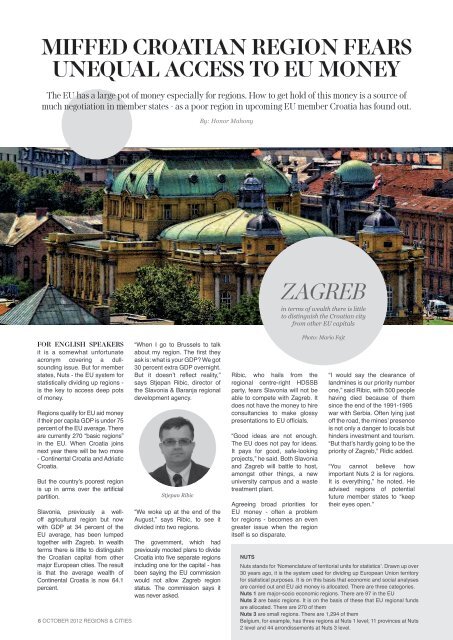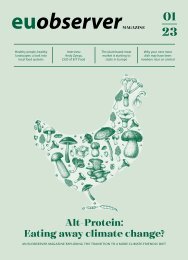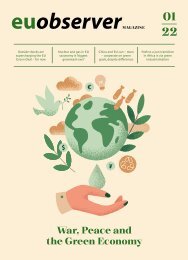Regions & Cities 2012: Economic Crisis & Austerity
The 2012 edition of EUobserver's Regions & Cities magazine looks at the impact of the economic crisis on Europe.
The 2012 edition of EUobserver's Regions & Cities magazine looks at the impact of the economic crisis on Europe.
You also want an ePaper? Increase the reach of your titles
YUMPU automatically turns print PDFs into web optimized ePapers that Google loves.
MIFFED CROAtIAN REGION FEARS<br />
UNEqUAl ACCESS to EU MONEy<br />
The EU has a large pot of money especially for regions. How to get hold of this money is a source of<br />
much negotiation in member states - as a poor region in upcoming EU member Croatia has found out.<br />
By: Honor Mahony<br />
in terms of wealth there is little<br />
to distinguish the Croatian city<br />
from other EU capitals<br />
FOR ENGLISH SPEAKERS<br />
it is a somewhat unfortunate<br />
acronym covering a dullsounding<br />
issue. But for member<br />
states, Nuts - the EU system for<br />
statistically dividing up regions -<br />
is the key to access deep pots<br />
of money.<br />
<strong>Regions</strong> qualify for EU aid money<br />
if their per capita GDP is under 75<br />
percent of the EU average. There<br />
are currently 270 “basic regions”<br />
in the EU. When Croatia joins<br />
next year there will be two more<br />
- Continental Croatia and Adriatic<br />
Croatia.<br />
But the country’s poorest region<br />
is up in arms over the artificial<br />
partition.<br />
Slavonia, previously a welloff<br />
agricultural region but now<br />
with GDP at 34 percent of the<br />
EU average, has been lumped<br />
together with Zagreb. In wealth<br />
terms there is little to distinguish<br />
the Croatian capital from other<br />
major European cities. The result<br />
is that the average wealth of<br />
Continental Croatia is now 64.1<br />
percent.<br />
6 OCTOBER <strong>2012</strong> REGIONS & CITIES<br />
“When I go to Brussels to talk<br />
about my region. The first they<br />
ask is: what is your GDP? We got<br />
30 percent extra GDP overnight.<br />
But it doesn’t reflect reality,”<br />
says Stjepan Ribic, director of<br />
the Slavonia & Baranja regional<br />
development agency.<br />
Stjepan Ribic<br />
“We woke up at the end of the<br />
August,” says Ribic, to see it<br />
divided into two regions.<br />
The government, which had<br />
previously mooted plans to divide<br />
Croatia into five separate regions<br />
including one for the capital - has<br />
been saying the EU commission<br />
would not allow Zagreb region<br />
status. The commission says it<br />
was never asked.<br />
Ribic, who hails from the<br />
regional centre-right HDSSB<br />
party, fears Slavonia will not be<br />
able to compete with Zagreb. It<br />
does not have the money to hire<br />
consultancies to make glossy<br />
presentations to EU officials.<br />
“Good ideas are not enough.<br />
The EU does not pay for ideas.<br />
It pays for good, safe-looking<br />
projects,” he said. Both Slavonia<br />
and Zagreb will battle to host,<br />
amongst other things, a new<br />
university campus and a waste<br />
treatment plant.<br />
Agreeing broad priorities for<br />
EU money - often a problem<br />
for regions - becomes an even<br />
greater issue when the region<br />
itself is so disparate.<br />
Photo: Mario Fajt<br />
“I would say the clearance of<br />
landmines is our priority number<br />
one,” said Ribic, with 500 people<br />
having died because of them<br />
since the end of the 1991-1995<br />
war with Serbia. Often lying just<br />
off the road, the mines’ presence<br />
is not only a danger to locals but<br />
hinders investment and tourism.<br />
“But that’s hardly going to be the<br />
priority of Zagreb,” Ridic added.<br />
“You cannot believe how<br />
important Nuts 2 is for regions.<br />
It is everything,” he noted. He<br />
advised regions of potential<br />
future member states to “keep<br />
their eyes open.”<br />
NUTS<br />
Nuts stands for ‘Nomenclature of territorial units for statistics’. Drawn up over<br />
30 years ago, it is the system used for dividing up European Union territory<br />
for statistical purposes. It is on this basis that economic and social analyses<br />
are carried out and EU aid money is allocated. There are three categories.<br />
Nuts 1 are major-socio economic regions. There are 97 in the EU<br />
Nuts 2 are basic regions. It is on the basis of these that EU regional funds<br />
are allocated. There are 270 of them<br />
Nuts 3 are small regions. There are 1,294 of them<br />
Belgium, for example, has three regions at Nuts 1 level; 11 provinces at Nuts<br />
2 level and 44 arrondissements at Nuts 3 level.

















